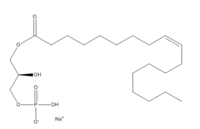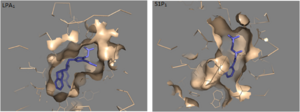Sandbox Reserved 1175
From Proteopedia
(Difference between revisions)
| Line 20: | Line 20: | ||
==Clinical Testing== | ==Clinical Testing== | ||
| - | LPA is still in the clinical stage of testing. So far the LPA receptors have had physiological effects on every organism that it has been tested with. There have been studies done looking at what happens with infertility, fibrosis, pain, and cancer when they come into contact with LPA receptors. LPA receptors are commonly found in serum and saliva. <ref name= "Moolenaar"/>. | + | LPA is still in the clinical stage of testing. So far the LPA receptors have had physiological effects on every organism that it has been tested with. There have been studies done looking at what happens with infertility, fibrosis, pain, and cancer when they come into contact with LPA receptors ,ref name= "Chrencik"/>. LPA receptors are commonly found in serum and saliva. <ref name= "Moolenaar"/>. |
===Pain=== | ===Pain=== | ||
| - | + | LPA, a signaling phospholipid, can attach to three specific G-protein-coupled receptors. LPA can activate multiple pathways in particular, Ras and Pho which belong to the family of GTPases <ref name= "Inoue"> DOI:10.1038/nm1060 </ref>. Another use of LPA is it can help in stimulation of cell migration <ref name= "Moolenaar" </ref>. | |
| - | === | + | ===Fibrosis=== |
| - | To look at the effects of LPA on | + | To look at the effects of LPA on fibrosis, there was a study done with mice <ref> PMID:18066075 </ref>. It was seen that with targeted deletion of LPA receptors the mice would be cured from fibrosis. Mice who had fibrosis were given LPA1 regulated LPA-induced fibroblast. Over time the mice who had fibrosis began to have their lungs repaired. The amount of fluid in their lungs decreased. |
</StructureSection> | </StructureSection> | ||
== References == | == References == | ||
<references/> | <references/> | ||
Revision as of 06:48, 29 March 2016
| This Sandbox is Reserved from Jan 11 through August 12, 2016 for use in the course CH462 Central Metabolism taught by R. Jeremy Johnson at the Butler University, Indianapolis, USA. This reservation includes Sandbox Reserved 1160 through Sandbox Reserved 1184. |
To get started:
More help: Help:Editing |
Human Lysophosphatodic Acid Receptor 1
| |||||||||||
References
- ↑ 1.0 1.1 1.2 Moolenaar WH, van Meeteren LA, Giepmans BN. The ins and outs of lysophosphatidic acid signaling. Bioessays. 2004 Aug;26(8):870-81. PMID:15273989 doi:http://dx.doi.org/10.1002/bies.20081
- ↑ 2.0 2.1 Chrencik JE, Roth CB, Terakado M, Kurata H, Omi R, Kihara Y, Warshaviak D, Nakade S, Asmar-Rovira G, Mileni M, Mizuno H, Griffith MT, Rodgers C, Han GW, Velasquez J, Chun J, Stevens RC, Hanson MA. Crystal Structure of Antagonist Bound Human Lysophosphatidic Acid Receptor 1. Cell. 2015 Jun 18;161(7):1633-43. doi: 10.1016/j.cell.2015.06.002. PMID:26091040 doi:http://dx.doi.org/10.1016/j.cell.2015.06.002
- ↑ Inoue M, Rashid MH, Fujita R, Contos JJ, Chun J, Ueda H. Initiation of neuropathic pain requires lysophosphatidic acid receptor signaling. Nat Med. 2004 Jul;10(7):712-8. Epub 2004 Jun 13. PMID:15195086 doi:http://dx.doi.org/10.1038/nm1060


